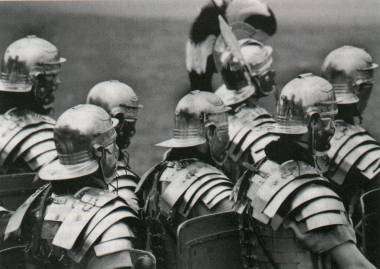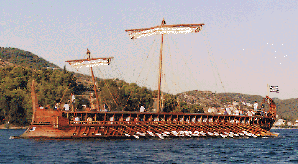|
|
|

The legions were extremely organized and disciplined.
The legions were trained by centurions, who were feared by the soldiers more than the enemy. They were often forced on long marches with heavy loads. If anyone objected or complained, they were killed. Whenever the roman army lost a battle, one out of every ten men were killed. This way, they would fight as hard as possible and only the best would survive.
The legions' formational dimensions were 2160 yard across and 220 yards deep. They used a wedge shaped formation so they could break through enemy lines. They also used the Testudo formation. Also known as the tortoise, this formation involved linking the shields together to deflect missiles. This formation is so efficient that it is still used today.

A trireme is really a galley that uses sails and oars. The sails would be used in normal travel (assuming there was wind), while the oars were used in battles, where manuverability and speed were exceedingly important. The reason triremes are called triremes is because of their 3 banks of oars. Such a trireme would have up to 170 rowers, and could possibly reach speeds of 10 knots. Earlier triremes had large brass rams in the front. During the First Punic War, the romans used a strategy where infantry would board the enemy ship, making sea battles into floating land battles. This way of fighting was more effective than ramming.
Home
Mail us!